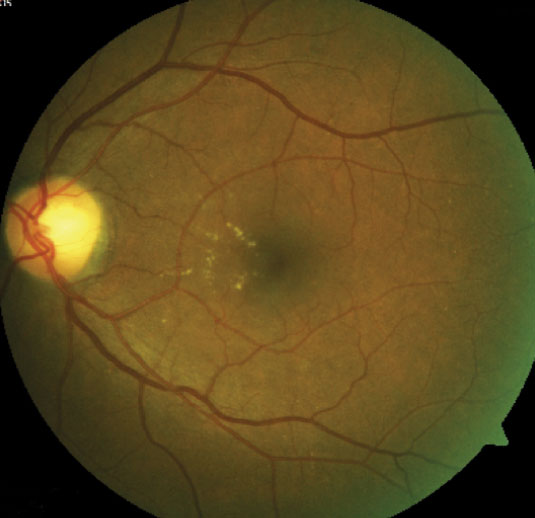 |
|
Researchers recently reported on factors that were either positively or negatively associated with CST fluctuation, which may aid in visual prognosis. Photo: Julie Torbit, OD. Click image to enlarge. |
Central subfield thickness (CST) fluctuations are often used to judge treatment response and predict visual acuity outcomes in diabetic macular edema (DME) patients, but experts point out that it’s still unclear which patients may be more likely to exhibit such fluctuations over time. A recent study investigated potential baseline factors and their association with CST fluctuations and reported that certain baseline characteristics such as presence of kidney disease and some modifiable factors including blood pressure may be at play.
In the post-hoc analysis of the DRCR.net Protocols T and V databases (n=1,197 eyes), the researchers calculated the standard deviation of all recorded CSTs for each patient. They analyzed this against baseline ocular and systemic factors using linear regression analysis.
The researchers reported that in Protocol T (559 eyes), mean CST standard deviation was 56.4±35.1µm. Factors positively associated with CST fluctuation included baseline urine albumin/creatinine ratio (for every 1000mg/g, CST point estimate was 3.5) and baseline CST (for every 10µm, 0.87). Baseline visual acuity was negatively associated with CST fluctuations (for every 10 ETDRS letters, -9.52) .
In Protocol V (638 eyes), mean CST standard deviation was 36.6±28.4µm. Female sex (2.18), systolic blood pressure (for every 1mm Hg, 0.11) and observation with deferred anti-VEGF injections (5.04) were positively associated with CST fluctuations. The researchers reported that type 2 diabetes (-7.37) and prompt anti-VEGF injections (-6.51) were negatively associated with CST fluctuations.
They concluded that the following may be associated with increased CST fluctuations in DME patients:
Worse baseline visual acuity
Baseline kidney disease
Hypertension
Female sex
Type 1 diabetes
Delayed anti-VEGF treatment
“Although the relationship between CST fluctuations and visual acuity was non-linear due to external factors such as treatment response and severity of macular edema—thereby making it difficult to determine the exact relationship among baseline factors, CST fluctuations and visual acuity—baseline factors established in this study may still hold the potential to serve as biophysical markers for CST fluctuations and perhaps visual prognosis,” the researchers wrote in their paper.
“Additionally, given that some of the identified factors such as baseline albumin/creatinine ratio and hypertension are modifiable, our study highlights the potential for early treatment and lifestyle modifications of systemic components outside of the eye to reduce CST fluctuations and possibly improve visual acuity.”
Torjani A, Mahmoudzadeh R, Salabati M, et al. Factors associated with fluctuations in central subfield thickness in patients with diabetic macular edema using DRCR Protocols T and V. Ophthalmology. September 23, 2022. [Epub ahead of print]. |

